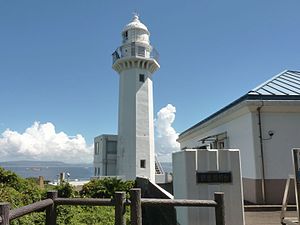Kannonzaki lighthouse
| Kannonzaki Lighthouse Kannon Saki 観 音 埼 灯台 |
||
|---|---|---|
| The Kannonzaki Lighthouse (2016) | ||
| Place: | Kannon Cape , Yokosuka | |
| Location: | Kanagawa , Japan | |
| Geographical location: | 35 ° 15 '22 " N , 139 ° 44' 43" E | |
| Fire carrier height : | 17 m | |
| Fire height : | 56 m | |
|
|
||
| Identifier : | Fl (2) W.15s | |
| Scope knows: | 19 nm (35.2 km ) | |
| Construction time: | 1869/1923/1925 | |
| Operating time: | since February 2, 1869 | |
| International ordinal number: | M 6360 | |
The Kannonzaki Lighthouse ( Japanese 観 音 埼 灯台 , Kannonzaki tōdai ) was built in 1869 at Kannon Cape (Kannonzaki) on the Miura Peninsula ( Kanagawa Prefecture , Japan ). The lighthouse is the oldest Japanese lighthouse of European design and is still in operation today.
history
Through the Anglo-Japanese Treaty of Amity and Commerce ( 日 英 修好 通商 条約 , Nichiei shūkō tsūshō jōyaku ) of 1858, the Tokugawa shogunate had committed itself to opening its trading ports to the western powers. The contract also included the creation of beacons and lighthouses as navigational aids on the Japanese coast. This resulted in the planning for various lighthouses in Tokyo Bay .
As the technical aspects of lighthouse construction were previously unknown in Japan, experts from Great Britain and France were called in for support. These should in particular support the planning of the structures and the purchase of the necessary equipment. The turmoil of the next few years, up to the Meiji restoration, hindered the planning for the lighthouse building, so that construction of the Kannonzaki lighthouse, the first lighthouse in Japan, did not begin until November 1868. The French Léonce Verny , who was entrusted with many construction projects of the beginning Japanese modernization, took over the construction management . On February 2, 1869, after a four-month construction period, the lighthouse's beacon was lit for the first time. In December of the same year, the Nojimazaki lighthouse , also built by Verny, followed as the second lighthouse in Japan , which is also still preserved today.
On April 26, 1922, the lighthouse was destroyed by an earthquake. The reason for this was the brick construction, which turned out to be insufficiently earthquake-proof. The lighthouse was rebuilt using cement, which however partially collapsed due to the Great Kanto earthquake on September 1, 1923. On June 1, 1925, the lighthouse was put back into operation in its current form.
Furnishing
In addition to the actual lighthouse, the lighthouse keeper's house and a building of the maritime traffic control center for Tokyo Bay also belong to the Kannonzaki lighthouse. The tower's beacon is characterized by two white flashes of light every 15 seconds. It is visible up to 19 nautical miles (35 km) with a light intensity of 140,000 candelas.
Web links
swell
- ^ Russ Rowlett: Lighthouses of Japan: Tōkyō Area ( English ) In: The Lighthouse Directory . University of North Carolina at Chapel Hill . Retrieved November 9, 2016.
- ↑ Michael R. Auslin, "Negotiating with Imperialism: The Unequal Treaties and the Culture of Japanese Diplomacy," Harvard University Press, 2004, ISBN 978-0674015210
- ↑ Ceccaldi, Dekeyser, Girault, Stora: "Global Change: Mankind-Marine Environment Interactions: Proceedings of the 13th French-Japanese Oceanography Symposium" (English), p. 240, Springer-Verlag , 2011, ISBN 978-9048186297
- ↑ Desmond Ball and Richard Tanter: "The Tools of Owatatsumi: Japan's Ocean Surveillance and Coastal Defense Capabilities" (English, PDF ; 6.94 MB), p. 67, at www.oapen.org, accessed on November 2, 2016
- ↑ "Information on the Kannonzaki Lighthouse" (Japanese) at www.lighthouse-japan.com, accessed on November 2, 2016
- ↑ "Information on the Kannonzaki Lighthouse" (Japanese) at www.yamatae.sakura.ne.jp, accessed on November 2, 2016

